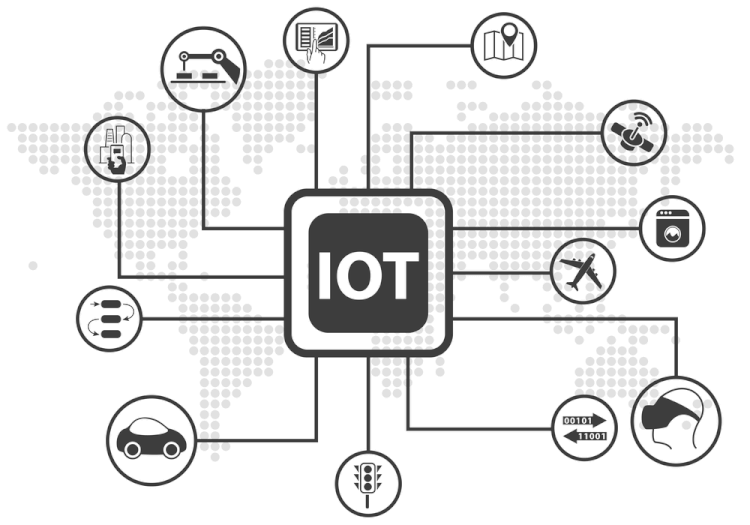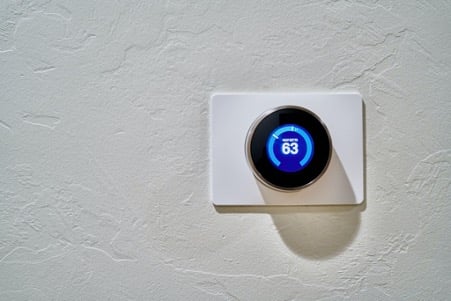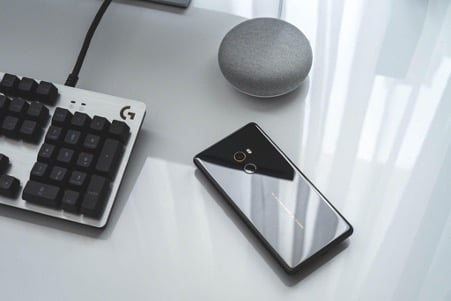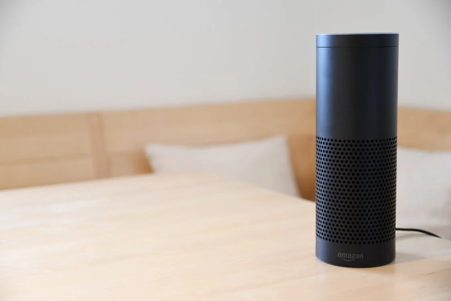We also explain the benefits and points to note when introducing IoT, so please read until the end.

Basic knowledge of IoT
Before introducing specific use cases of IoT, let’s first deepen our understanding of what IoT is.
What is IoT?
IoT is an acronym for “Internet of Things,” and is translated into Japanese as “Internet of Things.” In other words, it is a system that connects various things around us to the Internet.
Until recently, it was common to connect to the Internet from a computer at home or work. However, with the spread of mobile devices such as smartphones and tablets, it has become easier to access the Internet from anywhere. Furthermore, “smart home appliances” such as televisions and air conditioners that can be connected to the Internet are appearing one after another, making it possible to operate devices remotely even when you are far away.
There are great expectations for technology that utilizes IoT, as it has the potential to make life even more convenient and enrich society. Against this background, the IoT market continues to grow year by year, and is expected to further expand in the future.
How IoT works
Various home appliances and equipment targeted by IoT are equipped with sensors, cameras, etc. These sensors and cameras sense and collect information such as the condition of objects and the surrounding environment, and transmit this data to people and objects via the Internet. The sensors installed vary depending on the device, such as light sensors, temperature sensors, and acceleration sensors.
Let’s take smartwatches as an easy-to-understand example. A smartwatch acquires information such as biometric data such as heart rate and blood pressure, as well as the number of steps taken, based on sensors attached to the watch and GPS. That data is then sent to your smartphone via the internet or stored in the cloud, where it accumulates. The data collected in this way is analyzed by AI, converted into easy-to-understand information such as graphs, and then presented to the user again.
Until now, when selling something, the functionality and price of the item itself were considered to be the main sales criteria to determine whether it would sell or not. However, by introducing IoT, manufacturers are now able to add new added value to existing products.
What can be achieved with IoT technology

By using IoT technology, you can do four main things.
The keyword for what can be done with IoT is “remote”.
Now, let’s introduce one by one what you can do using IoT technology.
Remote control
In recent years, many IoT home appliances have been released. Typical examples include lighting equipment and air conditioners. By using home smart devices and sensors, you can remotely control lights, air conditioners, home appliances, etc. It also helps prevent people from forgetting to turn off these devices, improving safety and efficiency. Remote control of IoT devices will make our lives more comfortable.
You can also use smartphone apps to boil a bath or cook rice from anywhere. In this way, remote control of IoT devices makes life more comfortable.
Furthermore, remote pairing allows devices that are physically separated to communicate with each other.
In the medical field, online medical treatment is conducted using “wearable devices” that can be worn on clothing or wrapped around the hand.
The unique feature is that patients can wear a wearable device to monitor their health status, such as their blood pressure, in real time. This has the advantage of being able to provide medical examinations and guidance in remote locations such as the patient’s home and the hospital.
In addition, at manufacturing sites, sensors and control equipment are paired with PCs in the factory for data communication, and real-time monitoring and equipment control are performed from remote locations.
Detecting the movement of objects from a distance
By utilizing IoT, it is also possible to detect and monitor the movement of things from a distance.
It is also possible to construct a remote monitoring system using cameras and sensors.
Various sensors have been developed, including sensors that detect people and movement, and sensors that detect temperature.
The following are examples of what can be done by combining such sensors and IoT technology.
- Activate the camera and take images only when someone passes by
- Send signals to other devices and play alarms, etc.
Autonomous driving, which applies the brakes when it detects a pedestrian, is also an example of the use of IoT technology to detect the movement of objects.
Detect the status remotely
Using IoT, it is possible to detect conditions from a remote location, but even in this case, sensors are used.
For example, it uses temperature and humidity sensors to sound an alert when a certain value is exceeded.
Soil sensors also allow agriculture to monitor soil moisture, temperature, and nutrient levels.
Accelerometers that detect vibration, shock, and motion are used for structural monitoring of buildings, bridges, and vehicles.
Examples of IoT usage by industry

Now that we have a deeper understanding of IoT, let’s take a look at more specific use cases of IoT by industry. Convenient products and services with hidden potential are appearing one after another, including products that may become mainstream in the future.
Examples of use in the agricultural field
In the agricultural field, “smart agriculture,” which reduces the labor of agricultural work, is attracting attention. Smart agriculture is next-generation agriculture that uses cutting-edge technology that enables labor-saving and high-quality production. Specifically, sensors collect information on things like solar radiation and soil conditions, and calculate the timing of watering and fertilization, as well as the optimal amount of fertilizer.
In the agricultural industry, where labor shortages are becoming a major issue in the future due to the aging of workers and the lack of successors, there are high hopes for smart agriculture. By combining IoT with robot technology, it is possible to automatically water or spread fertilizer based on calculated data. It is not a dream to be able to automatically determine the harvest time, harvest, box and ship. It is expected that this technology will reduce the workload, improve productivity, and solve the problem of human resource shortages.
Examples of use in the medical field
One example of IoT being utilized in the medical field is wearable devices. This allows patients to wear a device connected to the Internet, which measures biological data such as body temperature, blood pressure, and pulse, and converts it into data.
If it becomes easier for medical institutions to collect detailed biological data on patients, it will help them make accurate diagnoses and provide appropriate treatment. When something abnormal is detected, it will help you make a quick diagnosis and take appropriate measures.
In recent years, there has been a serious shortage of doctors in the medical field, and the increasing burden placed on medical personnel has become a problem. IoT in medical institutions is an area of great interest from the perspective of improving the working environment for doctors. IoT specialized in medical care is called “IoMT (Internet of Medical Things),” and research and development is progressing to provide better medical services.
Examples of use in the logistics industry
In the logistics field, IoT is used for warehouse management, picking, delivery, etc. DX that uses the latest technologies such as IoT is called “Logistics 4.0” by the industry’s unique name.
For example, you may have heard of technology that uses robotics for picking tasks, automatically transporting shelves containing products to staff. This allows staff to quickly locate specific products without having to walk around a large warehouse. Furthermore, by attaching IC tags to the materials managed in the distribution warehouse, it is possible to manage the materials using drones flown into the sky.
In the area of delivery, a transportation management system called “TMS” has emerged that comprehensively manages transportation and delivery. This helps you plan efficient dispatches and accurately calculate freight and labor costs. Utilizing the GPS function, you can understand the location of each delivery vehicle in real time and guide drivers to the optimal route based on traffic congestion information. Additionally, you can manage delivery vehicle lease contracts and calculate expenses.
Due to the increased use of online shopping, the logistics industry is currently facing increased supply and complexity. It is also true that the burden on each worker is increasing, as the number of delivery drivers is decreasing due to the declining birthrate and aging of the population.
Examples of usage in the manufacturing industry
The manufacturing industry is an industry where work automation is progressing, with the introduction of industrial robots. With the advent of robots that can operate 24 hours a day, 365 days a year, productivity improvements and quality stabilization have been realized. IoT in the manufacturing industry is characterized by the collaboration of robotics with AI and M2M (machine-to-machine).
Introducing IoT to the manufacturing industry enables visualization, control, and automation. “Visualization” refers to visualizing the information collected by sensors. It collects information that is difficult to express, such as handwritten data and the amount of force applied during manufacturing, and visualizes it for easy analysis. “Control” uses the analysis results to help things operate efficiently. Furthermore, “automation” is the ability to automatically perform such control using AI and other means.
By introducing IoT into factories, we can also aim to create a ” smart factory ” (a thinking factory). A smart factory is a system that connects the systems and equipment in a factory to the Internet to visualize and automate various tasks. You can expect to improve productivity by understanding the operating status of your factory in detail and placing human resources in the appropriate locations. If you use a function to manage the status of equipment and issue an alert before it breaks down, you will be able to carry out maintenance and repairs as necessary and minimize the damage caused by equipment failure.
Familiar IoT usage examples
We have introduced examples of IoT usage in companies such as agriculture, medical care, and manufacturing, but now we will introduce more familiar usage examples of IoT that are closely related to daily life.
Multifunctional and versatile smart speaker
Multifunctional and versatile smart speakers are attracting attention as an example of IoT applications.
- Amazon’s Alexa
- Google’s “Google Assistant”
- Apple’s “Siri”
etc. are famous.
Smart speakers not only control IoT devices and home appliances, but also come with a variety of functions.
Additionally, more and more people are using smart speakers as part of their morning routine, as they can play music and provide audio information such as news, weather, traffic information, and stock prices.
You can also use your smart speaker to order products from online stores such as Amazon.
Smart locks are very popular among the dual-income generation.
Smart locks that utilize IoT are a convenient tool that is popular among the dual-income generation.
No more forgetting your house keys, forgetting to give them to family members, or worrying about losing your keys.
Depending on the product, it is also possible to manage car keys.
You can use the dedicated app to check the unlock history of your keys, and if there is unauthorized access, you will receive an alert notification, so you can also take security measures.
Refrigerator that lets you know how much stock is left
One of the home appliances that uses IoT is a refrigerator that allows you to see how much stock is left.
It has a built-in camera and weight sensor that monitors the remaining amount of food and drinks and sends this information through an app.
It is also possible to send an alert when food ingredients are nearing their expiry date.
You can also check the list of ingredients and drinks and create a shopping list by linking with the smartphone app.
Using IoT refrigerators not only contributes to reducing food waste, but also contributes to household finances.
Wearable underwear that shows your child’s health status
Wearable underwear that utilizes IoT has built-in sensors that measure body temperature, heart rate, breathing rate, etc.
This allows parents to monitor their children with peace of mind, even from a distance, as they can monitor their child’s health status in real time.
When an abnormality is detected, an alert notification will be sent via the smartphone app.
Furthermore, wearable underwear has been developed that is breathable, lightweight, and waterproof, making it comfortable to wear.
It seems that the day when it will be used for nursing care will be in the near future.
A GPS device that lets you know where your child is when they go to and from school.
One system that uses IoT to manage children going to and from school is a GPS device that children carry around with them.
It is useful for parents who want to check their child’s safety because they can know their child’s whereabouts in real time.
You can receive alerts from the app if you go outside of the range pre-set on your device.
This allows parents to quickly locate their children even if they do not return home or become lost.
Interesting IoT usage examples

So far, we have introduced typical IoT usage cases.
I’m sure there are many that you use or have heard of.
From here, we will introduce three interesting IoT usage cases that have become popular and have attracted attention.
MAMORIO
“MAMORIO” is an IoT device that can be used in conjunction with a smartphone to prevent the loss of items and confirm location information.
By attaching it to your keys, wallet, or your luggage, you can check your location information on your smartphone.
You can also always check where your pet is by attaching MAMORIO to your pet’s collar.
You can also set the app to notify you when your pet leaves a certain range.
You can also attach it to your car, so you can easily find it even in a large parking lot.
Foop
foop is a smart device that will change the way you grow vegetables.
It automatically manages the environmental conditions necessary for growing vegetables, such as light, water, and temperature, and supports the growth of vegetables.
You can operate it from your smartphone and check the progress of training and environmental conditions in real time, so you can go to work or travel with peace of mind.
It also automatically sets the optimal growing program for the type of vegetable.
The stylish design allows you to grow vegetables even in limited space such as in urban areas.
Crunchy machine
“Kari Kari Machine” is a service that supports pet meal management using IoT devices.
The Karikari Machine allows you to set the amount of food according to your pet’s weight and age, and can also record the amount eaten. It is also possible to adjust the amount of food by remote control.
You can accurately manage your pet’s diet even when you are away.
Additionally, if your pet overeats while you are away, you will receive a notification on your smartphone, so you can take immediate action.
Benefits of IoT for businesses

From here, for those who are positively considering the introduction of IoT, we will introduce the benefits that the use of IoT brings to companies.
Enables improved quality and productivity
By utilizing IoT, quality and productivity can be improved in many industries such as manufacturing, logistics, agriculture, and construction.
For quality improvement, IoT devices can be used to monitor product quality in real time.
If a quality abnormality occurs, by setting up an alert to be sent, you can prevent the occurrence of defective products at an early stage and ensure quality.
When it comes to improving productivity, IoT devices can be used to streamline work processes and reduce production line downtime.
Can reduce the number of workers
By utilizing IoT, it may be possible to reduce the number of workers required for some tasks.
Particularly at manufacturing sites, IoT sensors can be used to predict machine failures and perform necessary maintenance in advance, reducing the number of maintenance workers.
In some cases, automating tasks can free up your time for other tasks.
Know the issues to consider when introducing IoT

Although we have introduced the benefits of using IoT, there are also issues to consider when implementing it.
We will explain the five issues in an easy-to-understand manner.
Radio wave trouble
Radio wave troubles are an issue when introducing IoT.
Communication may become unstable due to radio wave interference, external noise, radio wave shielding, etc.
Radio wave problems may be resolved by taking measures such as selecting an appropriate installation location, setting the frequency band, and selecting the antenna.
It is also an effective method to obtain support from engineers who have technical knowledge about IoT device communication specifications and radio wave troubles.
Power supply trouble
Power supply problems are a major issue when introducing IoT.
Since power needs to be constantly supplied, power supply problems can affect the entire IoT system.
- Problems where power is not supplied to IoT devices due to power outages due to earthquakes, disasters, etc.
- An issue where an abnormality occurs in the power supply circuit, causing IoT devices to malfunction.
To solve these problems, it is necessary to have a backup power supply, such as an uninterruptible power supply or battery.
Securing human resources familiar with IoT
One of the issues to consider when introducing IoT is securing knowledgeable human resources.
Implementing an IoT system requires a wide range of knowledge, including hardware, software, cloud, and data analysis.
However, depending on the industry, there is a limited number of experienced human resources available for IoT technology, so it may be difficult to secure human resources.
IoT technology is evolving rapidly, so it is important to always learn the latest knowledge.
It is also necessary to utilize support from experts such as consulting firms, and to develop human resources in-house by utilizing online learning, training, seminars, etc.
Security trouble
Security measures are important when introducing IoT.
Unauthorized access to an IoT system may result in damage such as system misuse or leakage of personal information.
- Encrypt data to prevent information leaks
- Achieve secure authentication using multi-factor authentication
- Update regularly and fix vulnerabilities
- Continuously implement security measures such as introducing security monitoring tools
When it comes to security, the measures mentioned above are key.
Privacy trouble
When introducing IoT, it is also important to pay attention to privacy.
Since users’ actions and situations are recorded and analyzed, there is a possibility that this may violate the Personal Information Protection Act.
It is also necessary to take measures to prevent data leaks such as personal information leaks.
- Building a system that complies with laws and regulations regarding personal information protection
- Implement security measures such as data encryption and access control
- When collecting personal information, keep it to the minimum necessary and clarify the purpose of use.
Privacy measures, like security measures, require the above consideration from the system construction stage.
Summary
This time, we have introduced some well-known and interesting IoT usage cases.
Incorporating IoT products at home can lead to improved quality of life, such as reducing the burden of housework and reducing anxiety for families with children.
While the introduction of IoT in companies has security and privacy issues, there are many benefits such as reduced labor costs, increased efficiency, improved productivity, and improved safety.